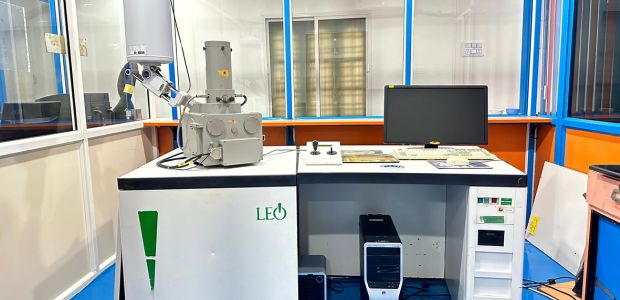Scanning Electron Microscopy
Schedule a MeetingScanning Electron Microscopy SEM Testing
“Scanning electron microscopy (SEM) is a game-changing technique for the morphological, texture, failure analysis and microstructural composition analysis and the analysis of contaminants present in samples.”
Scanning Electron Microscopy is a test process that produces a magnified image of a sample using an electron beam for analysis. It is highly effective in micro-analysis and failure mode analysis of materials and composites.
SEM analysis can facilitate the analysis of microscopic and nanoscopic materials and objects with great precision. scanning electron microscopy technique. There are two methods of electron detection when using SEM. Backscattered electrons can help with the analysis of the elemental composition of the sample and the secondary electrons emitted close to the surface can reveal relevant information about the topography and morphology of the sample’s surface. Combined with EDX, it can facilitate better analysis of the chemical and elemental composition of the samples.

Our Operation of Optical Microscopes
At our labs and research centers, we make sure to use only the best equipment pieces so that no error can appear in the final results we will provide. Several precautions are maintained so that the sample under consideration does not get damaged during the study.
We ensure that during each new sample test, a sterile and disinfected slide is used for better results. Nishka Research professionals ensure that all the arrangement is perfect and no single object is out of the place so that the final data recorded can have the least flaws. The entire material is studied thoroughly with different samples belonging to the same category until the optima studies are obtained.
Industries Served
- Aerospace
- Automotive
- Biomedical/biotechnology
- Compound Semiconductor
- Data Storage
- Defense
- Displays
- Electronics
- Industrial Products
- Lighting
- Pharmaceutical
- Photonics
- Polymer
- Semiconductor
- Solar Photovoltaics
- Telecommunications
SEM Applications
SEM testing is indispensable to mitigate contamination issues, perform failure mode and effects analysis and Identification & characterization of foreign particulates contamination. With the appropriate sampling methods, SEM becomes a powerful tool for an in-depth analysis.
Our Services
Energy Dispersive X-ray (EDX) Services:
Remote View SEM Services
Nishka Research routinely extends support for research, failure mode analysis, troubleshooting and quality control requirements to a multitude of clients across various industries, making us an ideal provider for your SEM analysis needs.
Frequently Asked Questions
What is SEM analysis?
What are the applications of SEM testing?
How does SEM work?
What are the advantages of SEM?
What is sputter coating in SEM analysis?
The sputter coating process works by bombarding the surface of the sample with a beam of positively charged particles, known as ions, which are emitted from a sputter source. The ions dislodge atoms from the surface of the sample, and the conductive material is deposited onto the sample to form a thin, uniform layer.
Sputter coating is important in SEM analysis because it enables the examination of non-conductive samples, which would otherwise not be visible in the SEM. By making the sample conductive, the electrons emitted by the SEM can interact with the sample and produce a high-resolution image.
It is important to note that sputter coating can alter the surface of the sample and introduce artefacts into the image. Therefore, it is important to choose a sputter coating material that is compatible with the sample and to carefully control the conditions of the sputter coating process to minimize the risk of sample damage and artefacts.
What are the limitations of SEM?
Here are few limitations of Scanning Electron Microscopy (SEM):
- Conductivity of sample: SEM requires that the sample being examined must be electro conductive or coated with a conductive material. This can limit the types of materials that can be analyzed using SEM.
- Vacuum essential: SEM operates in a vacuum environment, which can limit the types of samples that can be examined and the conditions under which they can be examined. Wet (Moistened) samples cannot be used in SEM.
- Sample preparation: SEM requires that samples be carefully prepared and mounted, which can be time-consuming and complex.
- Sample damage: There is a risk of sample damage during the SEM imaging process, especially for delicate or sensitive samples.
- Cost: SEM equipment and instrumentation can be expensive, and the process can be complex, requiring specialized knowledge and training.
- Resolution: While SEM provides high-resolution images, it may not be as sensitive as other imaging techniques, such as transmission electron microscopy (Even a nano particles can be examined), in terms of detecting subtle differences in sample structure and composition.
Why ChooseNishka Research
SEM analysis is critical for performing particle composition analysis. The high magnification imaging from our SEM analysis allows clients to understand the wear and tear properties of their material. Our SEM testing services provide analysis of the size, quantity and morphology of small particles. Using these analytical techniques, our team of experts can provide you with valuable insights to best optimize your product cycle.
Looking for a trusted partner to achieve your research goals? schedule a meeting with us, send us a request, or call us at +91 78427 98518 to learn more about our services and how we can support you.
Need help or have a question?

Nishka Research Brochure
We deliver next-gen research services, Testing & Consultation know more..
